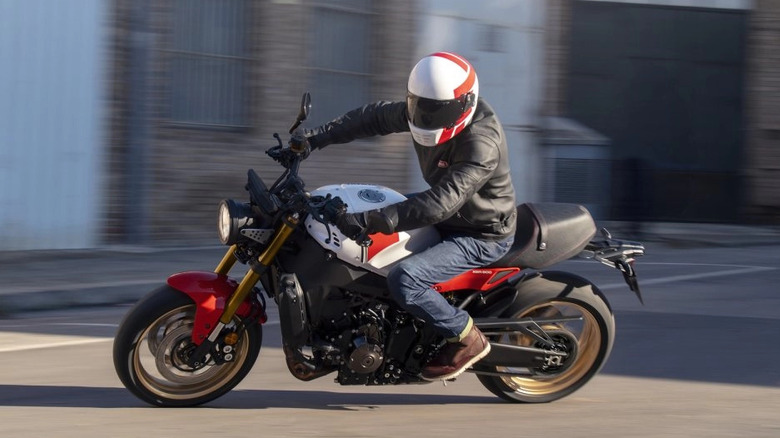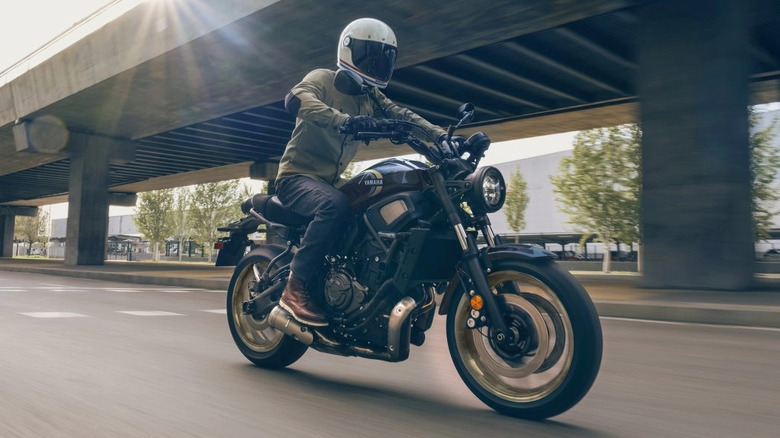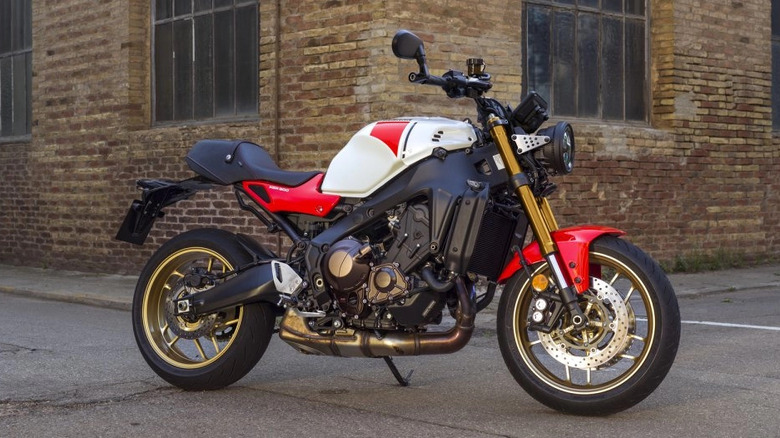How Much HP Does The Yamaha XSR900 Have & Is It A Good Bike For Beginners?
The XSR900 sits at the top of Yamaha's Sport Heritage lineup. Made up of retro-styled bikes and cruisers, all with circular headlights and fairing-free bodies, the Sport Heritage bikes lean on nostalgia quite heavily. Just because they have classic looks, though, doesn't mean they have old-school performance. The XSR900, specifically, is a powerful motorcycle that shares its powertrain with supersport bikes like the new Yamaha R9 and sporty Hyper Naked bikes like the MT-09. Given all the power that the CP3 engine makes, we'd recommend beginner motorcycle riders steer clear of the XSR900.
According to Yamaha's European website, the current XSR900 makes 117 hp and 68.5 lb-ft (119 ps and 93 Nm). Back in 2022, the XSR900 received a mid-cycle refresh, which introduced some visual updates and a bump in engine displacement that brought it to today's power levels. The inline three-cylinder went from 847cc to 890cc, and, in a Cycle World dyno test, put down 105.97 hp and 63.49 lb-ft of torque at the rear wheel. Those are pretty big numbers, and certainly more than required on a beginner bike.
I can say, from personal experience of owning the older generation 847cc XSR900 and having ridden newer versions, that the XSR900 is too powerful for someone who's just starting out. The XSR is also a bit pricey for a beginner bike, with an MSRP of $11,974 (including $625 destination fee and $750 supply chain surcharge).
What it's like to ride the XSR900
The current XSR900 has three riding modes for different scenarios: Sport, Street, and Rain. It also has other rider aids that come standard, including a Wheel Lift Control System, Traction Control, and Slide Control. The rider modes limit the amount of power delivered, but it's still relatively easy to get the front wheel off the ground with a quick flick of the right wrist, even with riding aids like wheelie control engaged. I always have a blast riding my XSR900, but I have to be careful how I apply power. New riders lacking good throttle control could get in trouble in a hurry, especially if they turn off the rider aids.
The XSR900 has a seat height of 32.1 inches, so most adults will be able to flat-foot it at lights. The upright riding position is also comfortable on longer rides, but it's relatively heavy for new riders. With the three-cylinder 890cc engine in the current model, Yamaha claims a 432-pound wet weight. That's not heavy for the class, but beginner bikes in the sub-400-pound range will be a little bit easier to handle, especially at slow speeds. Thankfully, there are a lot of these beginner bikes to choose from.
Beginner-friendly alternatives to the XSR900
There are several other bikes in Yamaha's Sport Heritage lineup, namely the V Star 250, Bolt R-Spec, and XSR700. Of the three, the V Star 250 is probably the best beginner bike. It has a totally approachable price of $5,749 (including $650 destination and $350 supply chain surcharge). It's small, manageable, fuel-efficient, and has a relatively low seat height. The V Star 250 weighs just 324 pounds, so parking it and learning slow-speed maneuvers will be much easier. The Bolt R-Spec is significantly larger, but its cruiser riding position makes it less intimidating to ride than the XSR900. The Bolt also has more power than the V Star (65 hp from the 942cc V-twin engine), so it'll be a bit more satisfying for riders who keep it around a while and learn to adapt. It also bridges the gap between the V Star and the XSR900 with an MSRP of $10,124 (including $650 destination and $500 supply surcharge).
If you're looking for a cafe-styled bike with lots of nostalgia factor, yet want to avoid buying an XSR900 as a first bike, there's also the XSR700. It's powered by a 689cc inline two-cylinder engine, making it much more approachable as a result. It makes 73.4 hp and 49.4 lb-ft (73.4 PS and 67 Nm). The XSR700 also weighs about 20 pounds less than the XSR900 — no featherweight, but a bit easier for beginners to handle. Total price for the more manageable XSR? A more affordable $9,799 (plus $600 destination and $600 supply chain surcharge).
Our methodology
I've been riding for years, and my recommendation here is based on my experience as well as that of riders all around me. Bikes with Yamaha's powerful CP3 engine can be very fun to ride and are seriously fast. But thrills and speed are hallmarks of Yamaha bikes for more experienced riders, and shouldn't be part of the equation for your first motorcycle. Learning the basics, gaining control of your bike, and being comfortable sharing the road with other motorists should all be higher priorities. Do that with a cheap, moderately powerful motorcycle, and your two-wheeled journey will be much more enjoyable.
What's more, if you're choosing a beginner bike, there's no point in picking something expensive. Whether it's parking your motorcycle in a crowded space, moving it around a parking lot, or coming across a slick section of road you didn't expect, there's a possibility that the bike will end up on its side. There's no fun in scratching up something with a big price tag. A used bike can be a great choice, too, especially if it'll help you save a bit of money.



